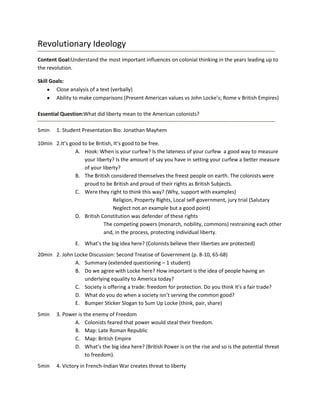
American History - Revolutionary Ideology Lesson Plan
- 1. Revolutionary Ideology Content Goal:Understand the most important influences on colonial thinking in the years leading up to the revolution. Skill Goals: Close analysis of a text (verbally) Ability to make comparisons (Present American values vs John Locke’s; Rome v British Empires) Essential Question:What did liberty mean to the American colonists? 5min 1. Student Presentation Bio: Jonathan Mayhem 10min 2.It’s good to be British, It’s good to be free. A. Hook: When is your curfew? Is the lateness of your curfew a good way to measure your liberty? Is the amount of say you have in setting your curfew a better measure of your liberty? B. The British considered themselves the freest people on earth. The colonists were proud to be British and proud of their rights as British Subjects. C. Were they right to think this way? (Why, support with examples) Religion, Property Rights, Local self-government, jury trial (Salutary Neglect not an example but a good point) D. British Constitution was defender of these rights The competing powers (monarch, nobility, commons) restraining each other and, in the process, protecting individual liberty. E. What’s the big idea here? (Colonists believe their liberties are protected) 20min 2. John Locke Discussion: Second Treatise of Government (p. 8-10, 65-68) A. Summary (extended questioning – 1 student) B. Do we agree with Locke here? How important is the idea of people having an underlying equality to America today? C. Society is offering a trade: freedom for protection. Do you think it’s a fair trade? D. What do you do when a society isn’t serving the common good? E. Bumper Sticker Slogan to Sum Up Locke (think, pair, share) 5min 3. Power is the enemy of Freedom A. Colonists feared that power would steal their freedom. B. Map: Late Roman Republic C. Map: British Empire D. What’s the big idea here? (British Power is on the rise and so is the potential threat to freedom). 5min 4. Victory in French-Indian War creates threat to liberty
- 2. War Debt -> Need to Raise Funds -> End of Salutary Neglect -> Not so Free Instead of running free, colonists find they’re like a dog on a Flexleash! 5min 5. Between the French-Indian War’s End and the declaration of dependence, there were three revolutions in thought that lead to independence 1. Representation (not having any) 2. Constitution not protecting rights 3. Sovereignty – Parliament has no legitimate power of colonies Assignment: Reading – Excerpts of source documents:Boston Town Meeting, Letters from a Farmer, Resolutions of the First Colonial Congress, Common Sense. Graphic organizer – Examining the ideas that drive each document. Exit Cards: What did liberty mean to American Colonists?